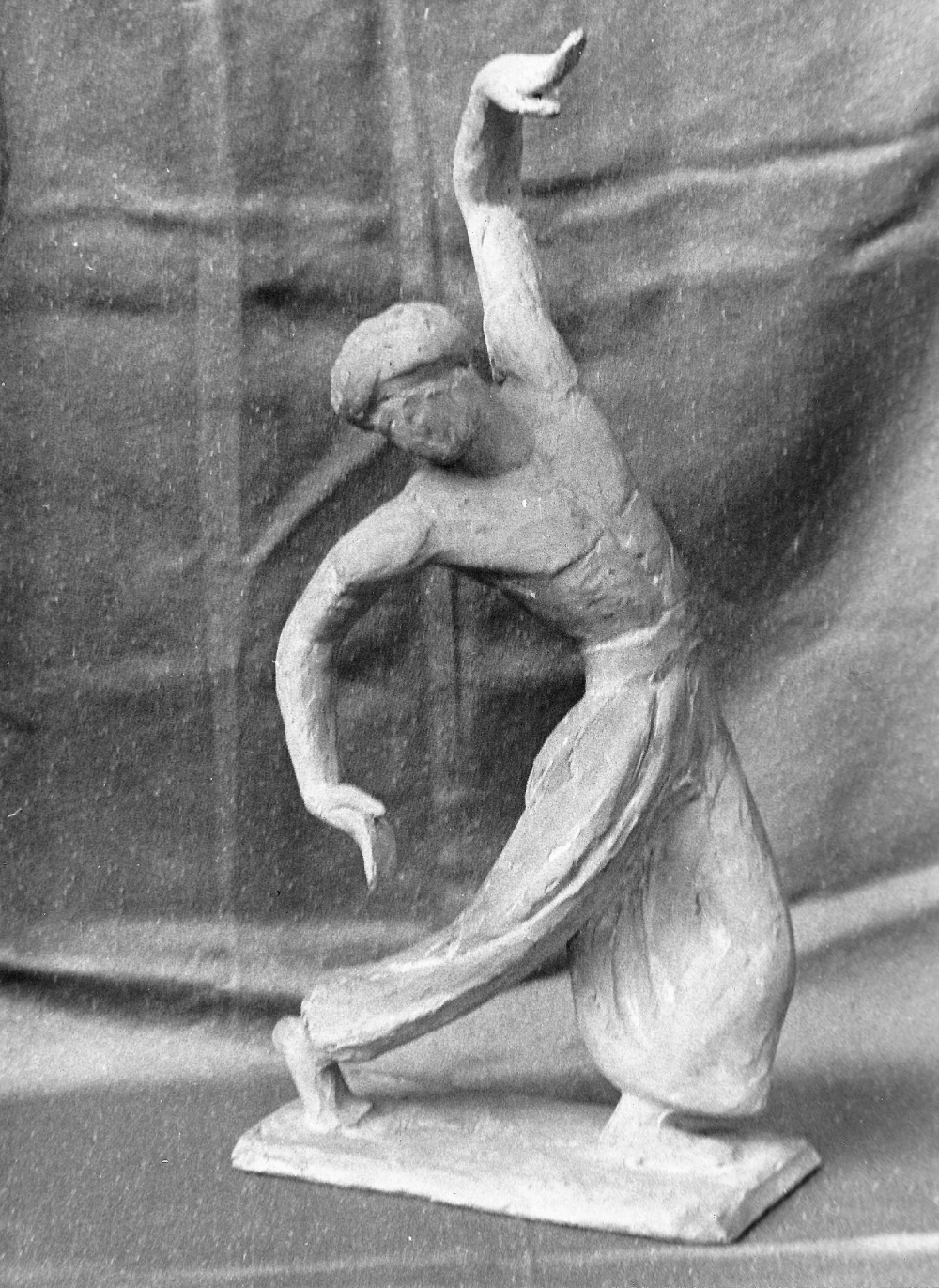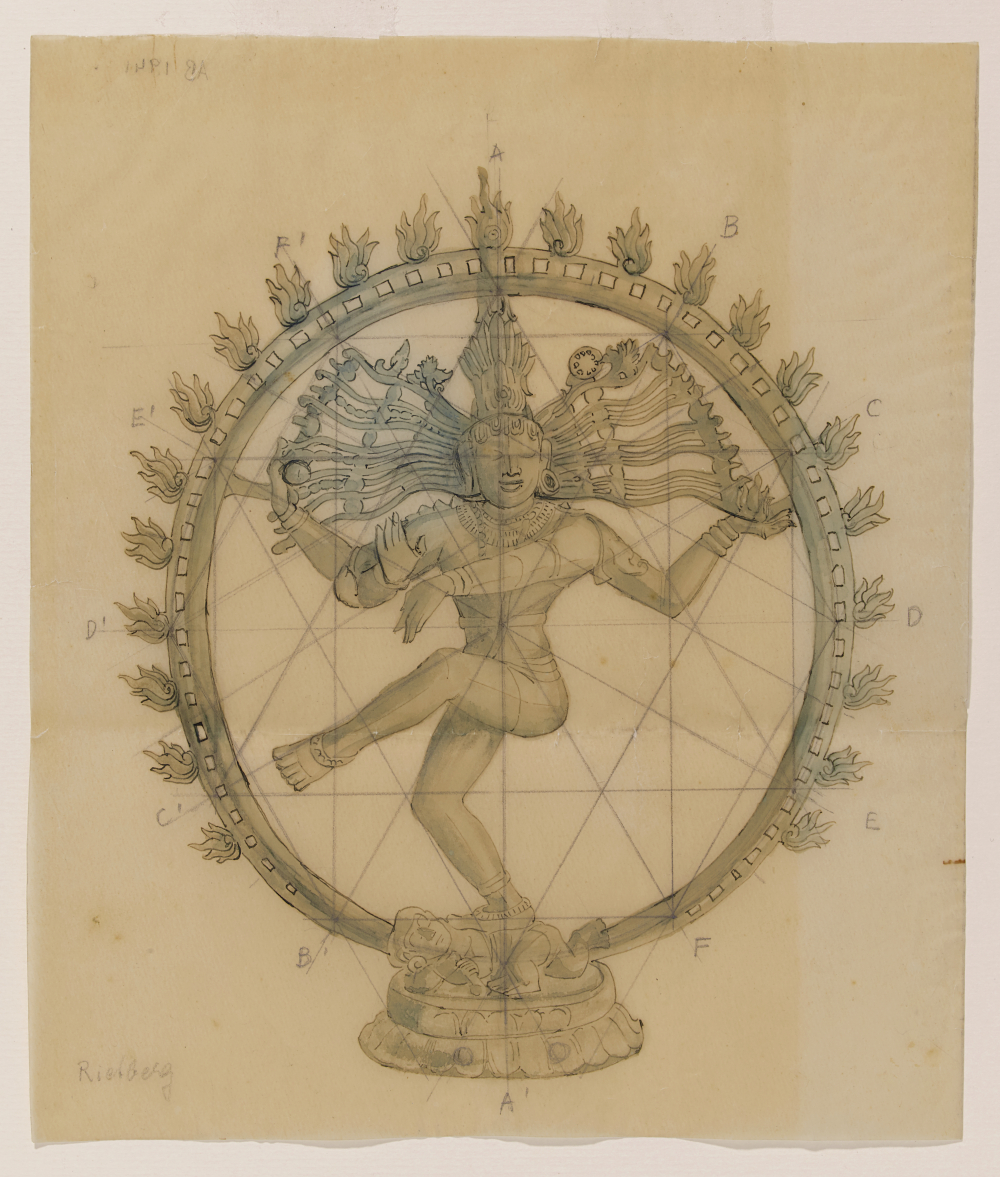Alice Boner (1889–1981) a Swiss artist—surprisingly little known—spent her life in 20th-century India and received the Padma Bhushan from the President of India in 1974. Her paintings and sculptures were much appreciated throughout her lifetime and she was awarded an honorary doctorate by the University of Zurich in 1969. Boner was born in Italy, brought up in Brussels, and received her training in painting and sculpture in Brussels and Basel. While visiting an exhibition in Zurich’s prestigious Kunsthaus, Boner met Uday Shankar, the Indian dancer, during one of his performances in the city in 1926. This meeting was to be a turning point in both Boner’s as well Shankar’s life. At hindsight, it may be said that this meeting was also an extremely significant moment in the history of Indian modern dance. About this significant meeting, marking the beginning of a long period of collaboration between Boner and Shnakar, Ruth Abraham (2007) writes:
It was during this period that Shankar met the Swiss sculptor Alice Boner in Zurich during his 1926 tour with the LanFranchis. The meeting proved mutually significant, as Shankar agreed to pose for Boner, a well-to-do leader in Parisian literary and art circles, so that 'she could make of him figurines in clay which were cast in bronze'. For Shankar, the encounter served as yet another turning point in his career, for by 1926, Boner (1889–1981) was an established artist, her work in sculpture and painting acclaimed by both the public and other artists. With her sister, the author Georgette Boner, Alice exerted her influence and affluence to assist other, less fortunate artists whom she believed exhibited great potential. Boner’s interest in India, harbored since youth, was renewed by her meeting with Shankar.
Alice Boner’s role in Shankar’s revisiting of India and its culture
Many European artists and dancers visited India during the early part of the 20th century. A growing interest in the cultures of the colonised countries, along with a fascination with artistic practices such as dance and music as well as the crafts and arts of little-known cultures of Asia, drew many artists to Asia. Anna Pavlova, Ruth St. Denis and Ted Shawn among many others travelled to India in the first half of the 20th century. During this time Uday Shankar’s career was going through a major shift. Anna Pavlova had requested Sir William Rothenstein to allow Shankar to join Pavlova’s troupe as a choreographer of her oriental dancers, and so Shankar was a part of the troupe for a while. He left his studies of Fine Arts at the Royal College of Art to tour with Pavlova. After his experience in the troupe, he tried to start his career as a choreographer/dancer based in the West, when he met Alice Boner.
The Swiss sculptor was fascinated by live bodies and invited Shankar to be her model, and also for a dance recital. She photographed, sketched sculpted his postures, and those provide an interesting insight into how both she and Shankar later used these picturized embodiments for their creative journeys. According to Ruth Abrahams (2007):
Boner, however, perceived a special quality in Shankar’s dance, one that transcended its vulgar cabaret surroundings to convey a sense of authority and authenticity generally absent from the fanciful gyrations of his 'exotic dance' counterparts. She was astute enough to recognize that this apparent authenticity was not merely representational, but rather integrated into an expressionistic portrayal.
Shankar is known to have taken a prolonged tour of India in 1927–28. Boner’s understanding of Shankar’s ability to create movements purely from an instinctive understanding and aesthetic ability seems to have encouraged a collaboration that proved extremely creative in the next few years. It is therefore extremely important to place alongside Uday Shankar’s interpretation of 'Indian culture' and sculptor Alice Boner’s contribution in framing that particular version of Indian culture for him. Her collaborative and supportive presence may have been crucial for Shankar to be able to establish a process of understanding his own country and culture better and also to create a strong base of movement practice—on the basis of his renewed relationship with India and its art. He was also drawn to the range of music and musical instruments he came across during the tour, and started collecting the musical instruments.
Shankar started his studio classes upon his return to Paris in 1928. This started an important phase in their journey together. The shaping of the next phase of Shankar’s career can be seen as being the handiwork of Alice Boner. Shankar’s performance in Paris was prepared with support from Boner—in more ways than one. She became the advisor, artistic manager, the benefactor and the overall support for Shankar’s endeavours and creative journey. Shankar’s new dance partner Simone Bariere (later known as Simkie) became an important part of Shankar’s repertoire. During this phase, Boner’s ideas and influence shaped Shankar’s career and also created the artistic space for him to explore the possibilities of creativity without being troubled by administrative work. Boner’s handling of tours, in and outside Europe, her handling of publicity, her help in creating the costumes, and her overall aesthetic and artistic sensibilities provided the much required encouragement for Shankar to explore and expand his artistic capabilities.
This phase was followed by their second tour of India starting December 1929, extending over nearly a year. The sizeable film footage/recordings of this tour are proof of the range of cultural practices experienced by both of them. Uday Shankar became fascinated by the local forms of art practice on one hand, while being enamoured by the temples and sculptures they saw, on the other. The photos and documentation of the tours undertaken by both of them—visiting historical sites as well as experiencing ways of life and culture of South Asia and Southeast Asia—presents ample proof of the way in which this phase shaped the way Shankar viewed dance and dance cultures for the rest of his life. Shankar’s fascination with the sculpturesque quality of dance movements, which became a permanent and important part of his dance repertoire, seems to have germinated from his viewing the sculptures in the temples of India with Boner. This trip culminated in Shankar’s creating a company of dancers and Indian musicians, and his experimentation with choreographies based on Indian myths and regional themes to the accompaniment of music composed by Indian musicians and Indian musical instruments. It is a period during which Shankar’s confidence in creating art that may be claimed as ‘Indian’ was encouraged by Alice Boner’s steady presence in his life and her knowledge and understanding of Indian art. The trip also helped Shankar to gain knowledge of local cultural practices in remote corners of India, and witness forms of dance, theatre and music from across India. This is the time he came in contact with forms such as Kathakali, saw community dances of Adivasi rituals, and experienced festivals in remote areas of India, mainly in the north, north-east and south.
Boner collected and documented sculptures, dresses and ritual instruments, and created a knowledge bank for Shankar to use in his performances. Shankar remained fascinated by many of the ornaments that he saw and acquired during his trips to southern India and Ceylon (Sri Lanka).
An artistic partnership/business venture
Boner and Shankar established a French Limited Liability Company, which would be governed by 'Existing Laws and The Present Articles of Association' and was owned by both of them. The company had as its object the 'creation, exploitation, sale and exploitation of all establishments and undertakings, organisation of performances, concerts, exhibitions, auditions and lectures with view of acquainting the public with Hindu music and choreographic art…' The Deed for the Limited Liability Company was registered under the name 'Compagnie Uday Shankar: Danses & Musique Hindus' in France on December 23, 1931. The deed spells out a capital of 20,000 francs, put in equal amounts of 12,500 francs each by Boner and Shankar at the time of the formation of the company.
Alice Boner took on herself the responsibility of managing the dance troupe of Uday Shankar for a period that may be considered as the beginning of the most successful period of Shankar’s newly formed dance company. The first show of the company, arranged by Boner on March 1931 in Paris, saw his dance and musical presentations being critically acclaimed. Shankar had arrived! He had made a leap from being an oriental dancer to an international choreographer, placed side by side with top-level modern dancers such as Ruth St. Denis, Ted Shawn, Martha Graham, Mary Wigman and others, in terms of the audience his performances were able to attract. At this phase, Boner needs to be acknowledged for having astutely planned and arranged a long tour of France and Switzerland. During this prolonged tour, Shankar’s company was invited to participate in Paris Exposition in 1931. Shankar’s own performance and the glimpses of his showmanship caught the attention of Sol Hurok, a famous European producer of concert theatre presentations in the United States, who invited him for a tour of America in 1931. Alice Boner and Shankar signed a contract with Hurok’s company for three years of touring. With this exposure, Shankar became a known name in the world of dance. Uday Shankar and his company of dancers and musicians toured Europe and America extensively. Through these years, Boner remained solidly with 'Shankar’s troupe of Hindu Dancers and Musicians'—the name the troupe became famous by. She helped the company with her artistic, aesthetic and administrative expertise. Hurok continued to arrange several shows in Europe and America for Shankar, presenting him alongside the already famous German modern dancer Mary Wigman and others. Shankar’s circle of admirers, acquaintances and well-wishers grew in number. Subsequent years saw Shankar’s recognition worldwide as a dancer with extraordinary understanding of showmanship and stage presence. He also started a number of negotiations with the Dartington Hall in England, with the aim of starting a centre for teaching of arts (with special focus on dance). These developments took the attention away from Boner’s quiet withdrawal from Shankar’s now-famous life and performance activities. Boner continued to be associated with Shankar’s troupe till 1938, though she had already disentangled herself from most of the day-to-day activities of the troupe.
The dancing body in Boner’s work
Many of Boner’s sculptures are of temple sculptures of India. Her grids and lines seem to have had a deep influence on Shankar’s use of sculpturesque fugues. The trajectories where Shankar pushed the limits of balance in his dance composition of Kartikeya much later in the '30s follow the grid structure drawn by Boner, in terms of the composition as well as weight management as the upper body pushes back while the dancer stands with one leg raised across in an angle to create a straight diagonal between the head and the big toe of the raised leg. Boner’s fascination with grids seem to have influenced the trained visual artist in Shankar in many ways in his later dances, that are fortunately recorded in his film Kalpana.


Uday Shankar photographed and sculpted by Alice Boner in Zurich (Photo © Museum Rietberg, Zürich, Switzerland)
A plethora of photos of Shankar taken by Boner in different temples and green rooms, personal photographs of him and Ravi Shankar in different, more relaxed times, posters made by her of Shankar and his troupe of dancers and musicians, are proof of the friendship and close ties that the two of them shared. Unfortunately, her relationship with Shankar came to an end and so did their business partnership in the second half of the 1930s.
Alice Boner’s Relationship with Indian Culture
Uday Shankar was called the cultural ambassador of India by the West but Alice Boner has been called the cultural ambassador of India by the people in India. Her diaries are her memoires of the time she spent in India, starting in the 1930s, as one of the first Western women settlers in India. Her relationship with India evolved through her exposure to life and art in India, seen and experienced first with Shankar, but later through personal connections with cultural and political luminaries such as Ananda Coomaraswamy, Rabindranath Tagore, Mahatma Gandhi, Jawaharlal Nehru and Alauddin Khan. Her close collaboration and partnership with Shankar was followed by her continued interest and patronage of performing artistes such as Balasaraswati, and Shanta Rao, who she continued to support for many years. Not much is written about her role in the establishment of Kerala Kalamandalam, as an institution for learning and dissemination of Kathakali. She also painted and sketched Kathakali performances and artists, which remain as testimonies of her fascination with the dance form.

(Photo © Museum Rietberg, Zürich, Switzerland).
It seems highly likely that the grid system used by Boner on weight-angle understanding of centre of gravity and balance in her work with Indian sculptures influenced Shankar’s choreographic understanding.
Boner’s fascination with seeing Indian sculptures through a geometric grid remained her basic contribution to Indian art. Thus viewing and creating of grids of representation of sculptures of Konark Temple through squares, triangles and circles became her major academic work. She also remained fascinated by representations and art around the figure of Goddess Kali in later years. She lived in Varanasi after leaving her position with Shankar’s company till she died in 1981.
References
Archival sources
Deed copy of company formed by Alice Boner and Uday Shankar, 1931, Dartington Hall Trust Archive, Tontes, Devon, England.
Published works
Abrahams, Ruth K. 2007. ‘Uday Shankar: The Early Years, 1900–1938.’ Dance Chronicle 30.3: 363–426.
Boner, Alice. 1993. Alice Boner Diaries: India 1934–1967. Delhi: Motilal Banarasidas.
Brendscheidt, Diana. 2011. Shiva Onstage: Uday Shankar's Company of Hindu Dancers and Musicians in Europe and the United States, 1931–38. Germany: LIT Jetlag.
Khokar, Mohan. 1983. His Dance, His Life: A Portrait of Uday Shankar. Delhi: Himalayan Books.
Majumdar, Nandini. 2016. ‘Remembering Alice Boner, a Swiss Artist in Search of Form in India’. Online at http://thewire.in/63284/remembering-alice-boner-a-swiss-artist-in-search-of-form-in-india (viewed on March 18, 2017).
Mukhopadhyay, Ashoke Kumar. 2004. Uday Shankar: Twentieth Century's Nataraja. New Delhi: Rupa & Co.
Vinay, Harsha. 2016. ‘Reliving a Legacy’. Online at http://www.thehindu.com/features/magazine/Reliving-a-legacy/article14591254.ece (viewed on March 18, 2017)
(Photo © Museum Rietberg, Zürich, Switzerland )












